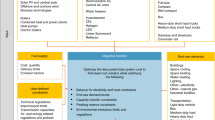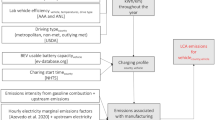Abstract
Current Chinese policy promotes the development of both electricity-propelled vehicles and carbon-free sources of power. Concern has been expressed that electric vehicles on average may emit more CO2 and conventional pollutants in China. Here, we explore the environmental implications of investments in different types of electric vehicle (public buses, taxis and private light-duty vehicles) and different modes (fast or slow) for charging under a range of different wind penetration levels. To do this, we take Beijing in 2020 as a case study and employ hourly simulation of vehicle charging behaviour and power system operation. Assuming the slow-charging option, we find that investments in electric private light-duty vehicles can result in an effective reduction in the emission of CO2 at several levels of wind penetration. The fast-charging option, however, is counter-productive. Electrifying buses and taxis offers the most effective option to reduce emissions of NOx, a major precursor for air pollution.
This is a preview of subscription content, access via your institution
Access options
Access Nature and 54 other Nature Portfolio journals
Get Nature+, our best-value online-access subscription
$29.99 / 30 days
cancel any time
Subscribe to this journal
Receive 12 digital issues and online access to articles
$119.00 per year
only $9.92 per issue
Buy this article
- Purchase on Springer Link
- Instant access to full article PDF
Prices may be subject to local taxes which are calculated during checkout




Similar content being viewed by others
References
Air Quality Review of Key Areas and 74 Cities in 2014 (in Chinese; Ministry of Environmental Protection of People’s Republic of China, 2015); http://www.mep.gov.cn/gkml/hbb/qt/201502/t20150202_295333.htm
Nielsen, C. P. & Ho, M. S. Clearer Skies Over China: Reconciling Air Quality, Climate, and Economics Goals (MIT Press, Cambridge, MA, 2013).
Zhang, Q., He, K. & Huo, H. Cleaning China’s air. Nature 484, 161–162 (2012).
Wu, Y. et al. On-road vehicle emission control in Beijing: past, present and future. Environ. Sci. Technol. 45, 147–153 (2011).
China Automotive Technology and Research Center (CATARC), Beijing Guoneng Yingchuang Energy Information Technology Co., Ltd. & Editorial Office of Year-book of Energy-saving and New-energy Vehicles 2011 Yearbook of Energy-saving and New Energy Vehicles (China Economic Publishing House, Beijing, 2011).
About the Support for Promotion of New-energy Vehicle in Shenyang, Changchun etc (in Chinese; Ministry of Finance, 2014); http://jjs.mof.gov.cn/zhengwuxinxi/tongzhigonggao/201402/t20140208_1041231.html
The Circular on Developing the Demonstration of Subsidies for Private Purchase of New Energy Vehicles (in Chinese; Ministry of Finance, Ministry of Science and Technology, Ministry of Industry and Information Technology & National Development and Reform Commission, 2010).
Li, F. China has the most public EV charging stations worldwide (China Daily, 2018); http://usa.chinadaily.com.cn/a/201801/11/WS5a5759d9a3102c394518e9e1.html
Annual Report on the Development of Electric Vehicle Charging Infrastructure in China (2016–2017) (in Chinese; National Energy Administration & China EV Charging Infrastructure Promotion Alliance, 2017); http://www.nea.gov.cn/136376732_14978397401671n.pdf
Wang, K. Beijing limits new car plates, boosts new energy vehicles (China Daily, 2017); http://www.chinadaily.com.cn/a/201712/15/WS5a33819aa3108bc8c6734ecb.html
Over 40% of Residential Areas are Equipped with Charging Facilities (in Chinese; Commission of Housing and Urban-Rural Development of Beijing, 2016) http://www.bjjs.gov.cn/bjjs/xxgk/xwfb/317878/index.shtml
Huo, H., Zhang, Q., Liu, F. & He, K. Climate and environmental effects of electric vehicles versus compressed natural gas vehicles in China: a life-cycle analysis at provincial level. Environ. Sci. Technol. 47, 1711–1718 (2013).
Wu, Y. et al. Energy consumption and CO2 emission impacts of vehicle electrification in three developed regions of China. Energy Policy 48, 537–550 (2012).
Kim, J. & Rahimi, M. Future energy loads for a large scale adoption of electric vehicles in the city of Los Angeles: impacts on greenhouse gas (GHG) emissions. Energy Policy 73, 620–630 (2014).
Zhang, S. et al. Historic and future trends of vehicle emissions in Beijing, 1998–2020: a policy assessment for the most stringent vehicle emission control program in China. Atmos. Environ. 89, 216–229 (2014).
Kang, C. et al. Balance of power: towards a more environmentally friendly, efficient, and effective integration of energy systems in China. IEEE Power Energy Mag. 11, 56–64 (2013).
Wang, J. et al. Impact of plug-in hybrid electric vehicles on power systems with demand response and wind power. Energy Policy 39, 4016–4021 (2011).
Sioshansi, R. & Denholm, P. Emissions impacts and benefits of plug-in hybrid electric vehicles and vehicle-to-grid services. Environ. Sci. Technol. 43, 1199–1204 (2009).
Liu, W., Hu, W., Lund, H. & Chen, Z. Electric vehicles and large-scale integration of wind power—the case of Inner Mongolia in China. Appl. Energy 104, 445–456 (2013).
Global Wind Statistics 2017 (Global Wind Energy Council, 2018); http://gwec.net/wp-content/uploads/vip/GWEC_PRstats2017_EN-003_FINAL.pdf
China Wind Energy Development Roadmap 2050 (International Energy Agency, 2011); https://www.iea.org/publications/freepublications/publication/china_wind.pdf
Grid Integration of China’s Wind Power Generation in 2016 (in Chinese; National Energy Administration of China, 2017); http://www.nea.gov.cn/2017-01/26/c_136014615.htm
Beijing Municipal Bureau of Statistics Beijing Statistical Yearbook (China Statistics Press, Beijing, China, 2014).
National Bureau of Statistics of China China City Statistical Yearbook 1998–2013 (China Statistics Press, Beijing, China, 1998–2013).
Luo, Z., Hu, Z., Song, Y., Xu, Z. & Lu, H. Optimal coordination of plug-in electric vehicles in power grids with cost-benefit analysis—part II: a case study in China. IEEE Trans. Power Syst. 28, 3556–3565 (2013).
Sun, R., Yu, H. & Du, Y. Time space distribution characteristics of taxi shift in Beijing. J. Transp. Syst. Eng. Inf. Technol. 14, 221–228 (2014) (in Chinese).
Beijing Transport Annual Report (in Chinese; Beijing Transportation Research Center, 2013); http://www.bjtrc.org.cn/
Emission Standard of Air Pollutants for Thermal Power Plants GB 13223-2011 (Ministry of Environmental Protection of China, 2011).
Five Companies Got the Bidding for 914 Electric Buses in Qingdao with a Total Amount of about 900 Million RMB (in Chinese; Electric Vehicle Resources Network, 2017); http://www.sohu.com/a/196982793_233844
The Clean Air Action Plan 2013–2017 (in Chinese; Beijing Municipal Government, 2013); http://fgcx.bjcourt.gov.cn:4601/law?fn=lar830s997.txt
Subramanian, A., Garcia, M. J., Callaway, D. S., Poolla, K. & Varaiya, P. Real-time scheduling of distributed resources. IEEE Trans. Smart Grid 4, 2122–2130 (2013).
Xu, Z., Callaway, D. S., Hu, Z. & Song, Y. Hierarchical coordination of heterogeneous flexible loads. IEEE Trans. Power Syst. 31, 4206–4216 (2016).
Zhang, H., Hu, Z., Xu, Z. & Song, Y. Evaluation of achievable vehicle-to-grid capacity using aggregate PEV model. IEEE Trans. Power Syst. 32, 784–794 (2017).
Carrión, M. & Arroyo, J. M. A computationally efficient mixed-integer linear formulation for the thermal unit commitment problem. IEEE Trans. Power Syst. 21, 1371–1378 (2006).
Chen, X. et al. Increasing the flexibility of combined heat and power for wind power integration in China: modeling and implications. IEEE Trans. Power Syst. 30, 1848–1857 (2015).
Wang, S. J., Shahidehpour, S. M., Kirschen, D. S., Mokhtari, S. & Irisarri, G. D. Short-term generation scheduling with transmission and environmental constraints using an augmented Lagrangian relaxation. IEEE Trans. Power Syst. 10, 1294–1301 (1995).
Chen, X., Lu, X., McElroy, M. B., Nielsen, C. P. & Kang, C. Synergies of wind power and electrified space heating: case study for Beijing. Environ. Sci. Technol. 48, 2016–2024 (2014).
Geng, Z., Chen, Q., Xia, Q., Kirschen, D. S. & Kang, C. Environmental generation scheduling considering air pollution control technologies and weather effects. IEEE Trans. Power Syst. 32, 127–136 (2017).
McElroy, M. B., Lu, X., Nielsen, C. P. & Wang, Y. Potential for wind generated electricity in China. Science 325, 1378–1380 (2009).
Connection Set for Conductive Charging of Electric Vehicles GB/T 20234.2-2015 (General Administration of Quality Supervision, Inspection and Quarantine, 2015).
Acknowledgements
The research was funded in part by the Harvard Global Institute. Additional support was provided by the Hui Fund of the Ash Center of the Harvard Kennedy School of Government. This research is also supported by the State Key Laboratory on Smart Grid Protection and Operation Control of NARI Group, through the open topic project (20171613).
Author information
Authors and Affiliations
Contributions
All authors contributed to all aspects of this work.
Corresponding authors
Ethics declarations
Competing interests
The authors declare no competing interests.
Additional information
Publisher’s note: Springer Nature remains neutral with regard to jurisdictional claims in published maps and institutional affiliations.
Supplementary information
Supplementary Information
Supplementary Figures 1–6, Supplementary Tables 1–10, Supplementary Notes 1–7 and Supplementary References
Supplementary Data 1
The spreadsheet presents the hourly power demand profiles of Jing-Jin-Tang region and Beijing city, as well as the hourly capacity factors for 12 typical days in each month of the year. Typical coal consumption rates for conventional thermal units and operational characteristics for CHP units are also presented
Rights and permissions
About this article
Cite this article
Chen, X., Zhang, H., Xu, Z. et al. Impacts of fleet types and charging modes for electric vehicles on emissions under different penetrations of wind power. Nat Energy 3, 413–421 (2018). https://doi.org/10.1038/s41560-018-0133-0
Received:
Accepted:
Published:
Issue Date:
DOI: https://doi.org/10.1038/s41560-018-0133-0
This article is cited by
-
Sustainable plug-in electric vehicle integration into power systems
Nature Reviews Electrical Engineering (2024)
-
Impact of battery electric vehicle usage on air quality in three Chinese first-tier cities
Scientific Reports (2024)
-
Co-optimizing the smart grid and electric public transit bus system
Optimization and Engineering (2024)
-
Sustainable development pathways for energies in Yangtze River Delta urban agglomeration
Scientific Reports (2023)
-
Global declarations on electric vehicles, carbon life cycle and Nash equilibrium
Clean Technologies and Environmental Policy (2023)



